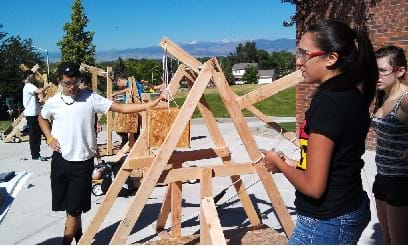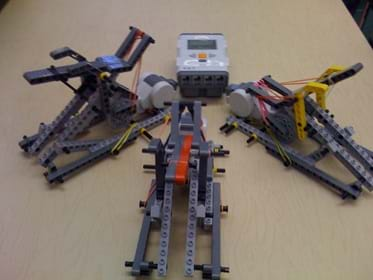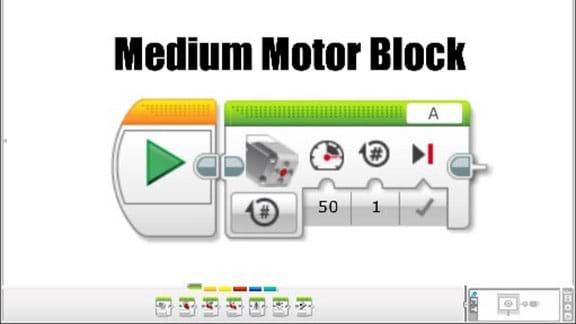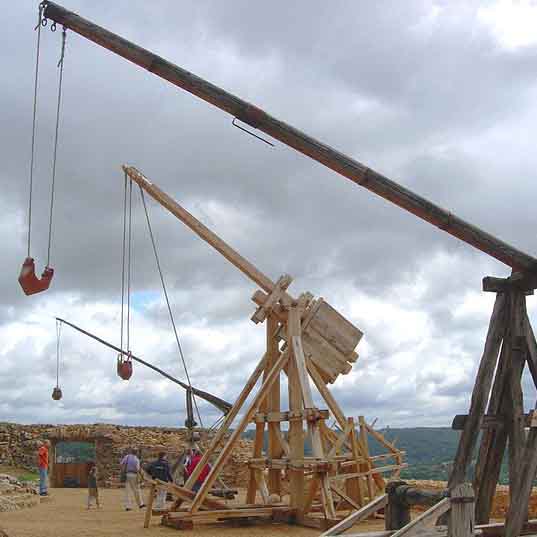Quick Look
Grade Level: 5 (4-6)
Time Required: 45 minutes
Expendable Cost/Group: US $10.00 This activity also requires non-expendable (reusable) LEGO MINDSTORMS EV3 robot kits and software for each group; see the Materials List for details.
Group Size: 4
Activity Dependency: None
Subject Areas: Algebra, Measurement, Physics, Science and Technology
NGSS Performance Expectations:

| 3-5-ETS1-1 |
| 3-5-ETS1-2 |
| 3-5-ETS1-3 |
| MS-ESS3-4 |
| MS-PS2-2 |
Summary
Students work as engineers to design and test trebuchets (in this case LEGO® MINDSTORMS® robots) that can launch objects. During the testing stage, they change one variable at a time to study its effect on the outcome of their designs. Specifically, they determine how far objects travel depending on their weights. As students learn about the different components of robot design and the specific function controls, they determine what design features are important for launching objects.
Engineering Connection
Engineers solve real-world problems. In fact, all engineers, including mechanical, electrical and chemical engineers, are faced with challenges that they solve via engineering designs, whether through the development of new technologies or improvements on existing functionality. In essence, engineers design and analyze solutions to generate new technology that is sophisticated and user friendly. Launching an object with precision is an ongoing challenge for people who use trebuchets; in this activity, students act as engineers to find solutions to this problem.
Learning Objectives
After this activity, students should be able to:
- Design a LEGO MINDSTORMS EV3 robot that can be used to launch objects.
- Program a robot using LEGO MINDSTORMS EV3 software.
- Determine the distance an object travels and relate it to its respective weight.
- Design and carry out a controlled engineering experiment.
Educational Standards
Each TeachEngineering lesson or activity is correlated to one or more K-12 science,
technology, engineering or math (STEM) educational standards.
All 100,000+ K-12 STEM standards covered in TeachEngineering are collected, maintained and packaged by the Achievement Standards Network (ASN),
a project of D2L (www.achievementstandards.org).
In the ASN, standards are hierarchically structured: first by source; e.g., by state; within source by type; e.g., science or mathematics;
within type by subtype, then by grade, etc.
Each TeachEngineering lesson or activity is correlated to one or more K-12 science, technology, engineering or math (STEM) educational standards.
All 100,000+ K-12 STEM standards covered in TeachEngineering are collected, maintained and packaged by the Achievement Standards Network (ASN), a project of D2L (www.achievementstandards.org).
In the ASN, standards are hierarchically structured: first by source; e.g., by state; within source by type; e.g., science or mathematics; within type by subtype, then by grade, etc.
NGSS: Next Generation Science Standards - Science
| NGSS Performance Expectation | ||
|---|---|---|
|
3-5-ETS1-1. Define a simple design problem reflecting a need or a want that includes specified criteria for success and constraints on materials, time, or cost. (Grades 3 - 5) Do you agree with this alignment? |
||
| Click to view other curriculum aligned to this Performance Expectation | ||
| This activity focuses on the following Three Dimensional Learning aspects of NGSS: | ||
| Science & Engineering Practices | Disciplinary Core Ideas | Crosscutting Concepts |
| Define a simple design problem that can be solved through the development of an object, tool, process, or system and includes several criteria for success and constraints on materials, time, or cost. Alignment agreement: | Possible solutions to a problem are limited by available materials and resources (constraints). The success of a designed solution is determined by considering the desired features of a solution (criteria). Different proposals for solutions can be compared on the basis of how well each one meets the specified criteria for success or how well each takes the constraints into account. Alignment agreement: | People's needs and wants change over time, as do their demands for new and improved technologies. Alignment agreement: |
| NGSS Performance Expectation | ||
|---|---|---|
|
3-5-ETS1-2. Generate and compare multiple possible solutions to a problem based on how well each is likely to meet the criteria and constraints of the problem. (Grades 3 - 5) Do you agree with this alignment? |
||
| Click to view other curriculum aligned to this Performance Expectation | ||
| This activity focuses on the following Three Dimensional Learning aspects of NGSS: | ||
| Science & Engineering Practices | Disciplinary Core Ideas | Crosscutting Concepts |
| Generate and compare multiple solutions to a problem based on how well they meet the criteria and constraints of the design problem. Alignment agreement: | Research on a problem should be carried out before beginning to design a solution. Testing a solution involves investigating how well it performs under a range of likely conditions. Alignment agreement: At whatever stage, communicating with peers about proposed solutions is an important part of the design process, and shared ideas can lead to improved designs.Alignment agreement: | Engineers improve existing technologies or develop new ones to increase their benefits, to decrease known risks, and to meet societal demands. Alignment agreement: |
| NGSS Performance Expectation | ||
|---|---|---|
|
3-5-ETS1-3. Plan and carry out fair tests in which variables are controlled and failure points are considered to identify aspects of a model or prototype that can be improved. (Grades 3 - 5) Do you agree with this alignment? |
||
| Click to view other curriculum aligned to this Performance Expectation | ||
| This activity focuses on the following Three Dimensional Learning aspects of NGSS: | ||
| Science & Engineering Practices | Disciplinary Core Ideas | Crosscutting Concepts |
| Plan and conduct an investigation collaboratively to produce data to serve as the basis for evidence, using fair tests in which variables are controlled and the number of trials considered. Alignment agreement: | Tests are often designed to identify failure points or difficulties, which suggest the elements of the design that need to be improved. Alignment agreement: Different solutions need to be tested in order to determine which of them best solves the problem, given the criteria and the constraints.Alignment agreement: | |
| NGSS Performance Expectation | ||
|---|---|---|
|
MS-ESS3-4. Construct an argument supported by evidence for how increases in human population and per-capita consumption of natural resources impact Earth's systems. (Grades 6 - 8) Do you agree with this alignment? |
||
| Click to view other curriculum aligned to this Performance Expectation | ||
| This activity focuses on the following Three Dimensional Learning aspects of NGSS: | ||
| Science & Engineering Practices | Disciplinary Core Ideas | Crosscutting Concepts |
| Construct an oral and written argument supported by empirical evidence and scientific reasoning to support or refute an explanation or a model for a phenomenon or a solution to a problem. Alignment agreement: | Typically as human populations and per-capita consumption of natural resources increase, so do the negative impacts on Earth unless the activities and technologies involved are engineered otherwise. Alignment agreement: | Cause and effect relationships may be used to predict phenomena in natural or designed systems. Alignment agreement: All human activity draws on natural resources and has both short and long-term consequences, positive as well as negative, for the health of people and the natural environment.Alignment agreement: Scientific knowledge can describe the consequences of actions but does not necessarily prescribe the decisions that society takes.Alignment agreement: |
| NGSS Performance Expectation | ||
|---|---|---|
|
MS-PS2-2. Plan an investigation to provide evidence that the change in an object's motion depends on the sum of the forces on the object and the mass of the object. (Grades 6 - 8) Do you agree with this alignment? |
||
| Click to view other curriculum aligned to this Performance Expectation | ||
| This activity focuses on the following Three Dimensional Learning aspects of NGSS: | ||
| Science & Engineering Practices | Disciplinary Core Ideas | Crosscutting Concepts |
| Plan an investigation individually and collaboratively, and in the design: identify independent and dependent variables and controls, what tools are needed to do the gathering, how measurements will be recorded, and how many data are needed to support a claim. Alignment agreement: Science knowledge is based upon logical and conceptual connections between evidence and explanations.Alignment agreement: | The motion of an object is determined by the sum of the forces acting on it; if the total force on the object is not zero, its motion will change. The greater the mass of the object, the greater the force needed to achieve the same change in motion. For any given object, a larger force causes a larger change in motion. Alignment agreement: All positions of objects and the directions of forces and motions must be described in an arbitrarily chosen reference frame and arbitrarily chosen units of size. In order to share information with other people, these choices must also be shared.Alignment agreement: | Explanations of stability and change in natural or designed systems can be constructed by examining the changes over time and forces at different scales. Alignment agreement: |
Common Core State Standards - Math
-
Draw a scaled picture graph and a scaled bar graph to represent a data set with several categories. Solve one- and two-step "how many more" and "how many less" problems using information presented in scaled bar graphs.
(Grade
3)
More Details
Do you agree with this alignment?
-
Represent and interpret data.
(Grade
5)
More Details
Do you agree with this alignment?
-
Fluently divide multi-digit numbers using the standard algorithm.
(Grade
6)
More Details
Do you agree with this alignment?
-
Display numerical data in plots on a number line, including dot plots, histograms, and box plots.
(Grade
6)
More Details
Do you agree with this alignment?
International Technology and Engineering Educators Association - Technology
-
Models are used to communicate and test design ideas and processes.
(Grades
3 -
5)
More Details
Do you agree with this alignment?
-
The process of experimentation, which is common in science, can also be used to solve technological problems.
(Grades
3 -
5)
More Details
Do you agree with this alignment?
State Standards
New York - Math
-
Draw a scaled picture graph and a scaled bar graph to represent a data set with several categories. Solve one- and two-step "how many more" and "how many less" problems using information presented in scaled bar graphs.
(Grade
3)
More Details
Do you agree with this alignment?
-
Represent and interpret data.
(Grade
5)
More Details
Do you agree with this alignment?
-
Fluently divide multi-digit numbers using the standard algorithm.
(Grade
6)
More Details
Do you agree with this alignment?
-
Display numerical data in plots on a number line, including dot plots, histograms, and box plots.
(Grade
6)
More Details
Do you agree with this alignment?
New York - Science
-
Define a simple design problem reflecting a need or a want that includes specified criteria for success and constraints on materials, time, or cost.
(Grades
3 -
5)
More Details
Do you agree with this alignment?
-
Generate and compare multiple possible solutions to a problem based on how well each is likely to meet the criteria and constraints of the problem.
(Grades
3 -
5)
More Details
Do you agree with this alignment?
-
Plan and carry out fair tests in which variables are controlled and failure points are considered to identify aspects of a model or prototype that can be improved.
(Grades
3 -
5)
More Details
Do you agree with this alignment?
-
Plan and conduct an investigation to provide evidence that the change in an object's motion depends on the sum of the forces on the object and the mass of the object.
(Grades
6 -
8)
More Details
Do you agree with this alignment?
-
Construct an argument supported by evidence for how increases in human population and per-capita consumption of natural resources impact Earth's systems.
(Grades
6 -
8)
More Details
Do you agree with this alignment?
Materials List
Each group needs:
- LEGO MINDSTORMS EV3 robot, such as EV3 Core Set (5003400) at https://education.lego.com/en-us/products/lego-mindstorms-education-ev3-core-set/5003400#lego-mindstorms-education-ev3
- LEGO MINDSTORMS Education EV3 Software 1.2.1, free online, you have to register a LEGO account first; at https://www.lego.com/en-us/mindstorms/downloads/download-software
- computer, loaded with EV3 1.2.1 software
- 2-3 sheets of copy paper (recycled is fine)
Note: This activity can also be conducted with the older (and no longer sold) LEGO MINDSTORMS NXT set instead of EV3; see below for those supplies:
- LEGO MINDSTORMS NXT robot, such as the NXT Base Set
- computer loaded with the NXT 2.1 software
To share with the entire class:
- robot built from a LEGO MINDSTORMS EV3 kit
- access to a computer
- 1 eraser
- 1 tube of Chapstick®
- 1 tennis ball
- 1-2 gum drops
- 1 paper ball (made of a crumpled piece of printer paper)
- 1 ping pong ball
- tape measure
- scale
Worksheets and Attachments
Visit [www.teachengineering.org/activities/view/nyu_trebuchet_activity1] to print or download.Pre-Req Knowledge
Basic concepts of a how a trebuchet functions.
Introduction/Motivation
Who loves watching objects fly through the air? (Give students times to discuss among themselves.) The term launch is often used to describe how far an object can travel. Trebuchets are devices that can launch object through the air. They were designed during medieval times to throw payloads (heavy objects) at enemies. Believe it or not, friendly competitions exist in some areas today in which trebuchets are used to launch pumpkins and even pianos. During this type of competition, a team wins when their trebuchet launches a pumpkin the farthest. Can you imagine how far a trebuchet would have to launch a pumpkin in order to win? (Give students time to guess a distance.)
In this activity, you design and test a trebuchet—actually a robot—to determine how far an object will travel based on its weight. Then, you adjust the angle and the length of the robot arm and determine how far different objects will travel, given modified variables. Basically, through experimentation, you learn how to design the best type of trebuchet to launch a variety of objects.
Why are we learning about trebuchets? I'm glad you asked! Trebuchets are an important educational tool because they demonstrate several principles encountered in basic physics—a branch of science that studies matter and its motion. Today, we will use computers and robots to model some of these physics concepts.
So, in this engineering activity, you apply math and science to predict how objects move through air as you design, build and program your own robotic creation to propel objects through the air. You also learn the importance of a variable, which is something that can be changed. By changing one variable at a time, you can determine what makes an object travel farther. Let's start launching!
Procedure
Background
During the first century, the Romans figured out different ways to make projectiles reach a certain location. During battle, they had to reiterate their designs in real time so that objects they hurled reached their opponents. The Romans applied a great deal of math and science, as well as trial and error, to solve this problem; the result of their efforts was the design of a crude, but effective, trebuchet—a type of catapult. Today, we use the trebuchet for both advanced solutions, as well as for entertaining purposes, such as catapulting pumpkins in friendly competition.
Before the Activity
- Gather materials and make copies of the How Far Does It Go? Worksheet, one per student.
- Load the EV3 software onto the computer.
- Divide the class into groups of four students each and assign each group member one of the following tasks: Launcher Driver (launches the object); Launcher Passenger (prepares the launcher); Measurer (measures how far the object travels); and Recorder (records the data observed from launches).
With the Students
Part 1: Preparing the Robot
- Have groups design their own robot launchers. Since many ways exist to design robots, tell students that this is an open-ended design project. (See some examples of student-designed projects in Figure 1.)

Figure 1. Example trebuchet robots. - Have students build their own robots before moving on to the programming stage. Since no set of instructions are provided for building, encourage students to be creative and work together to come up with viable designs.
- Following Figure 2, instruct students to program the robot to launch objects. If the program does not look like Figure 2, then instruct students to look in their pallet on the left side of the window for the program and make sure the motor, direction and power agree with Figure 2. The arrow in Figure 2 represents the direction, and the semi-circle filled with the orange color represents the power.
- Once programmed, have students plug the cable into motor A, located on the EV3 brick.
- Open the MINDSTORMS program and ask students to drag the motor block to the orange square; select the motor, power and direction. It is important that students understand they must have one motor do one rotation forward in order for the launcher to work.
Part 2: Preparing for the Launch
- Review correct measurement skills with students and teach them how to measure distance.
- Show students the variouis objects available to be launched, and ask them to predict which will travel the farthest.

Figure 2. The MINDSTORMS program image. - Ask students: What do you think will happen to the object's travel distance when the arm angle is changed?
- Ask students: What do you think will happen if you increase/decrease the angle or increase/decrease the length of the arm?
Part 3: The Launch
- Show students the objects to be launched again. Have them use a scale to determine and record the weight of each object.
- Direct students to take turns within their groups to launch objects. To do this, take an object and place it at the end of the arm for launching. (Note: Watch that students do not launch objects at each other.)
- Once launched, have groups measure the distance traveled (that is, the distance from the robot to the object); be sure students know the weight of each object before they launch it.
- Instruct students to record the object's distance traveled on their worksheets. Make sure they measure where the object first hits the ground, not where it rolls or slides to.)
- Once all groups have obtained data for their first trials, change the variables, repeating steps #2-4 for each variable change. First, change the angle of the arm and next, return the arm angle to its original setting but change the arm length).
- Direct students to complete the follow-up questions on their worksheets.
Vocabulary/Definitions
angle: The amount of rotation that separates two vectors.
constant: The quantity that remains constant in a given equation.
distance: The amount of space between objects.
length: The measure of how long something is from one end to another.
variable: The quantity that changes in a given equation.
Assessment
Pre-Activity Assessment
Guessing Game: Have students weigh the different objects. Ask them to predict which object will go the farthest, giving reasons for their answers.
Activity Embedded Assessment
Design a Robot: Direct students to design robots that will be able to launch objects. Explain that this is called open-ended design since there is no one right way. Ask them to explain to you how their designed launchers function to launch objects.
Post-Activity Assessment
Worksheet: Have students use the How Far Does It Go? Worksheet to record their trebuchet experiment data and results. Review their data, graphs and answers to gauge their level of comprehension.
Tuning the Equation: Ask students what happens when both the arm length and arm angle are changed? Ask them how far the object goes when these two variables are manipulated together.
Re-Design: Ask students to think about how changing variables (that is, the arm length and arm angle) affected their robot performances. As engineers, how would they re-design their existing robots to launch an object the farthest? How would they modify the design if accuracy was more important than distance?
Investigating Questions
- Which object went the farthest? Why? (Answer: The paper object went the farthest because it was the lightest.)
- What happened when the length of the arm was changed? (Answers: When the length of the arm was increased, the velocity and power of the object increased. Also when the length of the arm is longer, the angle of release is smaller. When the arm is shorter, the distance the object traveled is shorter; when the arm is longer, the distance that the object traveled is longer.)
- What happened when the angle of the arm was changed? (Answers: When the angle is smaller, the distance is shorter; when the angle is bigger, the distance is larger.)
- As engineers, what concepts did you apply to solve this problem? (Answers: We applied math, science and our own creativity to effectively design trebuchets; engineers incorporate all of these concepts as they design, analyze and iterate product designs.)
Safety Issues
- Remind students to only launch towards unoccupied space, never towards other people.
Troubleshooting Tips
Remind students to test their launchers before they begin to launch the objects.
Remind students that all launches should be precise; they should not estimate their launches.
The rubber bands on their robot launchers should have some sort of tension; students may need to adjust the tension after they have launched an object.
Activity Scaling
For upper grades, have students experiment with other materials, and launch them with different angles and arm lengths. Specifically, challenge students to create robots with long arms and find out what length impairs the function of the arm. Additionally, experiment to find out what arm length is not strong enough to launch an object and what length provides the best launch.
Subscribe
Get the inside scoop on all things TeachEngineering such as new site features, curriculum updates, video releases, and more by signing up for our newsletter!More Curriculum Like This

Students work as teams of engineers to design and build their own trebuchets. They research how to build and test their trebuchets, evaluate their results, and present their results and design process to the class.
References
Hewitt, Paul. Conceptual Physics. Upper Saddle River, NJ: Prentice Hall, 2002.
Zitzewitz, Paul. Physics Principles and Problems. Columbus, OH: McGraw-Hill, 2002.
Copyright
© 2013 by Regents of the University of Colorado; original © 2013 Polytechnic Institute of New York UniversityContributors
Jennifer S. Haghpanah, Janet YowellSupporting Program
AMPS GK-12 Program, Polytechnic Institute of New York UniversityAcknowledgements
This activity was developed by the Applying Mechatronics to Promote Science (AMPS) Program funded by National Science Foundation GK-12 grant no. 0741714. However, these contents do not necessarily represent the policies of the NSF, and you should not assume endorsement by the federal government.
Last modified: October 16, 2020







User Comments & Tips